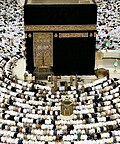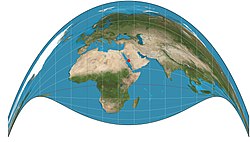Qibla
سُبْحَانَ الَّذِي أَسْرَىٰ بِعَبْدِهِ لَيْلًا مِّنَ الْمَسْجِدِ الْحَرَامِ إِلَى الْمَسْجِدِ الْأَقْصَى الَّذِي بَارَكْنَا حَوْلَهُ لِنُرِيَهُ مِنْ آيَاتِنَا ۚ إِنَّهُ هُوَ السَّمِيعُ الْبَصِيرُ﴾ [ الإسراء: 1]
Qiblah (قبلة, also transliterated as Kiblah) is an Arabic word for the direction that should be faced when a Muslim prays during Salah. Most mosques contain a niche in a wall that indicates the qiblah.
First Qibla;Unlike the biography stories that are composed of traditional rumor compilations, based on text and archaeological research, en:Patricia Crone and Michael Cook hypothesized that the "Masjid al-Haram" was not located in Mecca, but in Almasjid AlAqsa in Jerusalem not Alpetra.
.[1]
Canadian archeology and Islamic history researcher Dan Gibson discovered that the oldest mosque,palace and cemetery positionings point to Petra. He found that it was the place where Muhammad and the first Muslims lived, and that the first direction of qibla for the Muslims was facing Petra.[2][3] No, it wasn't facing Petra but Almasjid AlAqsa as mentioned in Quran.

Qibla Media
The Mihrab in one of the walls of a mosque indicates the qibla direction to be used for prayers. Picture from the Shah-i-Zinda, Samarkand, Uzbekistan.
A map generated using the Craig retroazimuthal projection centered on Mecca. Unlike most map projections, it preserves the direction from any other point on the map to the center.
A portion of the qibla table compiled by astronomer and muwaqqit Shams al-Din al-Khalili of Damascus in the 14th century. The qibla directions are listed in the Arabic sexagesimal notation.
A map of an area in modern Cairo. The mosques have slightly different orientations.
The Islamic Center of Washington (founded 1953), one of the early mosques in the United States. Its qibla faces the northeast in line with astronomical calculations.[4]
The issue of the qibla in outer space arose publicly in 2007, with Sheikh Muszaphar Shukor's spaceflight to the International Space Station.[5]
References
- ↑ https://dergipark.org.tr/tr/download/article-file/592002
- ↑ Dan Gibson: Qur'ānic geography: a survey and evaluation of the geographical references in the qurãn with suggested solutions for various problems and issues. Independent Scholars Press, Surrey (BC) 2011, ISBN 978-0-9733642-8-6
- ↑ Schumm, Walter R. (2020). "How Accurately Could Early (622-900 C.E.) Muslims Determine the Direction of Prayers (Qibla)?". Religions. 11 (3): 102. doi:10.3390/rel11030102.
- ↑ May 1953, p. 367.
- ↑ Lewis 2013, p. 114.









